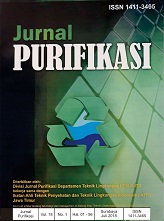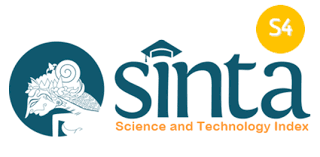Optimasi Hidrolik Pengaduk Lambat Tipe Sekat Berlubang
Main Article Content
Abstract
Water treatment Plant to treat raw water from river water generally has a flash mixing, slow mixing, clarifier and filter unit. Selection of unit type base on energy used generally there are two choices that is using mechanical or hydraulic power. Hydraulic type water treatment plant units have the advantage of being more efficient in energy use and require no mechanical equipment vulnerable to damage. So the current trend of drinking water treatment plant building entirely or partly on the ground. By utilizing the existing raw water pump energy, the processing unit, especially fash mixing and slow mixing, can work in a hydraulic-gravity manner. In this research continuous flow experiments were conducted on fash mixer units, slow mixer and sedimentation. The main focus of this research is the application of a hydraulic slow mixing type perforated. The slow mixing unit consists of four compartments, each separated by a perforated partition, and floc performed is sedimented in a aclarifier. The parameters studied were headloss, gradient velocity, dischrage coefficient and removal efficiency of turbidity. The objectives of this research are to know the efficiency of turbidity removal and the best composition of gradient velocity, headloss through perforated, and the magnitude of the discharge coefficient. The results of research showed that the performance of the perforated slow mixing is very well with turbidity removal reached 98%. The best Gradient velocity compositions are G: 86, 30, 14 dt-1 and Headloss of 174, 34, 9 mm. Based on the measurement of headloss and flow rate, the average discharge coefficient Cd is 0,63.
Downloads
Article Details
Submission of a manuscript to Jurnal Purifikasi means that the work has never been published in another journal and is not under consideration for publication elsewhere. The author hereby agrees to submit the copyright of the manuscript and its contents to Jurnal Purifikasi, if accepted for publication. Accepted manuscripts will be published in printed form where the ISSN is bound in printed form, not in online form (pdf). Authors are not allowed to publish their work in other forms (journals) without permission from the Jurnal Purifikasi manager.
By submitting a manuscript, the author is deemed to know all the rights and obligations attached to each manuscript.








